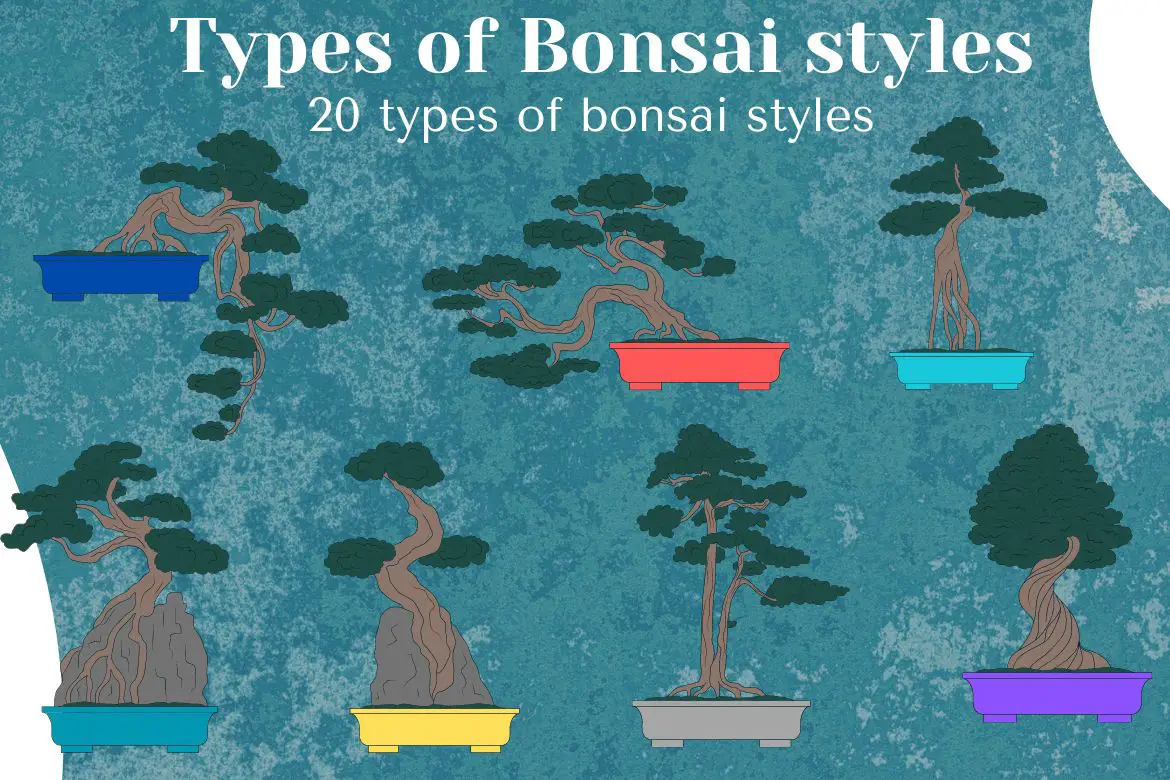Bonsai is an art form that imitates nature by shaping the trees grown in trays to resemble the trees found in the countryside or forest.
These shapes have their own characteristic forms.
The most widely used bonsai styles have been officially catalogued and given specific names so that bonsai enthusiasts can distinguish and identify various shapes easily.
Bonsai trees are given a certain shape or style by cutting, pruning and wiring. It takes a degree of skill, adaptable material, and most importantly, patience to create these characteristic shapes.
Although the Chinese were the ones who practiced the art of Bonsai styling (more than 2 millennia before Japanese), the official styling stemmed from Japan.
Styling a bonsai tree is all about personal creativity and it is not just limited to the styles mentioned below. However, an understanding of the fundamental bonsai styles is vital to successfully train bonsai trees and also serves as a guide.
Various styles of Bonsai can be divided into 3 categories:
- Single trunk
- Multi trunk
- Multi tree
Formal upright Bonsai style – Chokkan

As the name suggests, this type of tree is straight, upright, stiff, and very formal, a shape that occurs frequently in nature when the environment is optimal i.e. there is no severe weather, a lack of adverse conditions, as well as a constant supply of suitable nutrients and water.
From the soil level all the way up to the apex of the tree, the trunk should taper very evenly in this bonsai style.
As a result of this straightness and taper, this style creates a very elegant and statuesque design that cannot be found in other bonsai styles.
In some cases, these trees may appear symmetrical, but that is not always the case, as a certain amount of asymmetry will give them a more pleasing and natural appearance.
Informal upright Bonsai style – Moyogi

In both the natural world and in bonsai, this is probably the most commonly encountered style.
A bonsai in this style is one of the easiest styles to create, making it an ideal style for beginners.
Trees in the wild will have bending and curved trunks, and the direction of their trunks will change as they compete with nearby trees and other structures for resources. Additionally, the weather also plays a part in the changing shape of the tree.
The natural curves of some trees can be utilized to create a pleasing bonsai design.
To create a natural looking moyogi design, make sure that the branches are emerging from the outer side of the trunk curve.
Slanting Bonsai style – Shakan
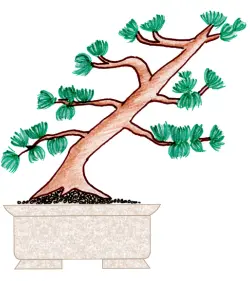
A tree exposed to strong winds and severe weather is the inspiration for this bonsai style. The bonsai style looks like as if the tree has been bent at an angle slanting away from the strong winds.
In nature, trees on cliff tops and mountainous areas can be seen adapting to strong winds and slanting at an angle.
The more pronounced this slanting becomes, the more the bonsai style falls into the windswept style category. However, sometimes it is a little difficult to draw the difference between the two bonsai styles.
Broom style Bonsai – Hokidachi
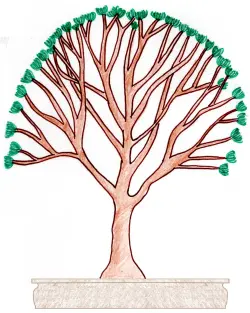
As the name suggests, this bonsai style resembles the shape of a household broom.
In parks and gardens around the world, you can see this bonsai style as full-size trees. It originated from the natural shapes of various kinds of Zelkova trees. Consequently, it is most suitable for these types of trees, but other types can also be successfully styled.
It is especially easy to train deciduous trees into broom-style bonsai, because deciduous trees produce a good array of branches quickly.
All branches should be pinched frequently throughout the growing season so as to maximize branch development.
Semi cascade Bonsai style – Han-kengai

This bonsai style mimics a tree which is subjected to extreme growing conditions.
This bonsai tree style is meant to appear as though the trees are very old trees that have grown from a rock face or a quarry or may even be found on a riverbank. There is a sense of the tree struggling to reach the sunlight.
Apart from trying to get the light, the tree can also be in an almost horizontal bent state because of falling debris and rocks at such locations.
Woody plants, such as Cotoneaster and Juniper make ideal contenders for semi-cascade bonsai style.
Cascade Bonsai style – Kengai
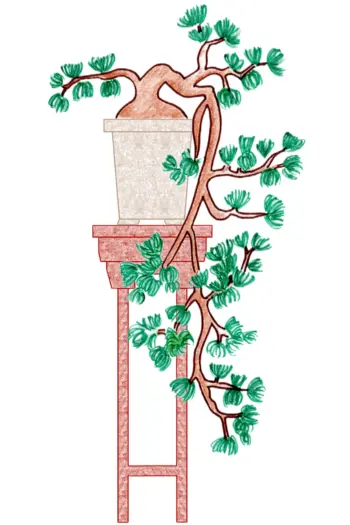
Similarly to semi-cascade bonsai style trees, these trees resemble trees that have grown under extremely difficult conditions. For example, a tree growing on the side of a rock face.
This style of bonsai depicts a tree which is exposed to numerous factors such as rock falls, heavy snowfall, and avalanches. Furthermore, its own weight is dragging it down.
Windswept Bonsai style – Fukinagashi
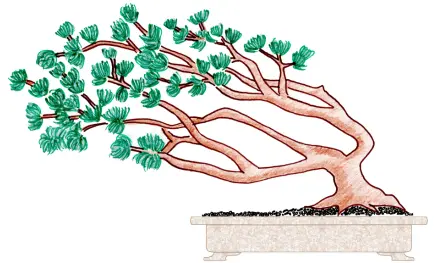
Windswept bonsai style is made to represent a tree which is exposed to extreme winds. This bonsai design is similar to slanting bonsai style but more pronounced.
Trees typically have straight trunks, with just the top part curving away from the direction of the wind.
It is possible to create a bonsai in the windswept style from almost any plant, although a tree with a leaning trunk would be easier for beginners.
Literati Bonsai style – Bunjingi
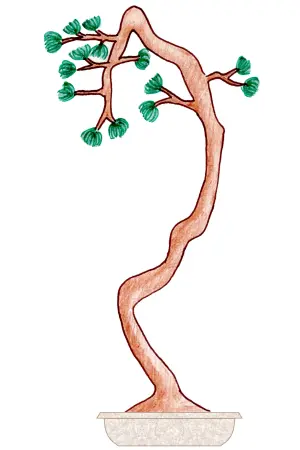
Literati bonsai style is unusual and does not adhere to the general rules of bonsai design.
When many trees have grown together over a long period of time, then some have died or been removed, leaving only a few trees standing, this style of trees can be seen.
Due to the stiff competition for available light, the trees will have grown tall and slim, and their foliage will be found on or near the tops of the trees.
Pines are often found growing in this style in the wild.
There is a great deal of value in the literati bonsai style, because almost any plant that is tall can be turned into a bonsai using it.
Additionally, the literati bonsai style is also a good idea for plants which are not a good fit for any other bonsai style.
Exposed Root Bonsai style – Neagari
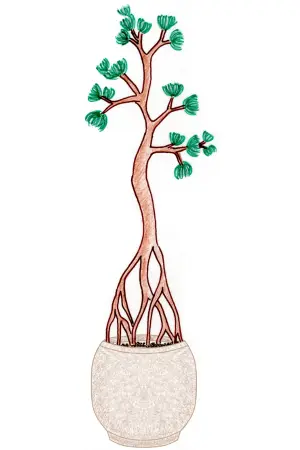
This bonsai style is made to show a tree whose roots are uncovered from the soil because of prolonged exposure to elements such as rain and wind.
It appears as if the tree is standing on stilts.
Exposed Root bonsai style can be achieved by growing a plant with thick roots. However, a beginner can also make this bonsai style by purchasing a bonsai tree with thick roots.
Driftwood Bonsai style (Shari) – Sharimiki
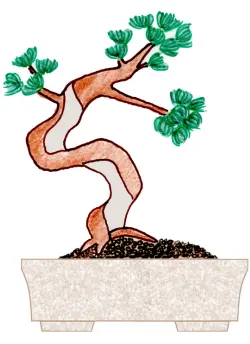
Driftwood bonsai style is considered to be one of the more advanced bonsai styling techniques. The trunk is stripped of its bark like a dead tree. It is also sometimes confused with “Sabamiki” style. However, that style is generally given to split trunk bonsai style.
This style tries to mimic the look of old juniper or pine trees with patches of missing bark, exposing the white inner trunk.
A plant with thick trunk is preferred for this bonsai style. A section of the bark is removed from the plant.
Another way to make it is to use a piece of driftwood and wrap it with a young plant.
This technique is called “wrap-around“.
Split Trunk Bonsai style – Sabamiki
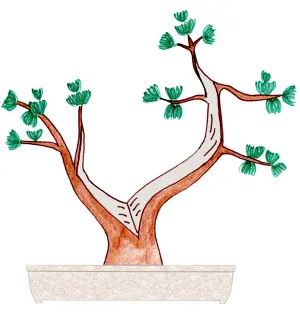
The trunk is torn, split, bare in parts. This deadwood bonsai technique creates a split in your tree’s trunk for aesthetic reasons. A split usually occurs from the base of your bonsai’s trunk to its tip, giving the illusion that it has been struck by lightning or has been aged by deep trunk damage.
Planted in rock Bonsai style – Ishisuki
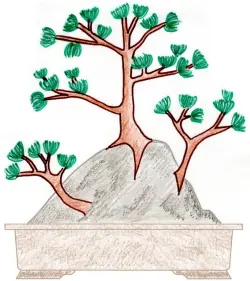
Throughout the world, trees can be seen growing on or through rocks. The roots of these trees take many years to grow through the rocks.
The roots try to penetrate the rocks to reach the soil in search of nutrients or to protect themselves from the harsh sun.
Root in rock bonsai style, as the name suggests, is a style which depicts this natural phenomenon on a miniature scale.
Juniper bonsai are considered suitable for this bonsai style. This bonsai style is also known as root in rook or Growing in a rock. Also, Ishisuki is also sometimes called as Shitsuki.
Spiral trunk Bonsai style – Bankan
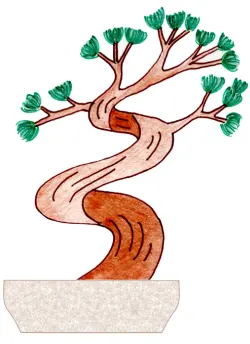
The fact that many Chinese bonsai artists follow this style clearly indicates its strong Chinese roots.
It is not uncommon to find paintings of trees such as this on ancient Chinese artifacts.
In this style of bonsai, a variety of plants can be trained, but it is obviously preferred if the trunk of the plant has a very flexible structure, in which case wire can easily be applied to alter the trunk’s form.
In the next step, the branch structure is shaped to blend well with the trunk line.
Forest Bonsai style – Yose-ue
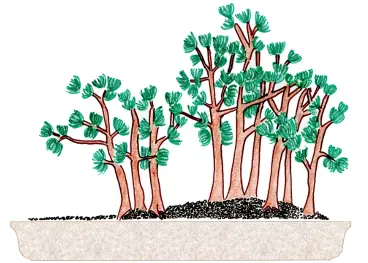
The aim of this style of bonsai planting is to simulate the appearance of a miniature copse, spinney, small forest, or a large forest.
You can use any number of trees provided the number of trees is odd. This gives a natural balanced appearance to this bonsai style.
Trees with the most development are planted in the middle. Several plantings may be required to achieve this effect.
Root over rock Bonsai style – Sekijoju
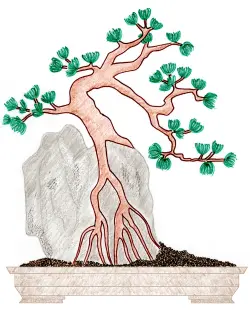
In this type of bonsai style, the roots of the bonsai tree cover the surface of a rock before going into the soil.
The tree needs to have long roots for this design to work.
In case the tree does not have long roots, you can place the tree in a long container temporarily. When the roots are of the desired length, remove the tree from the pot and wash away the soil.
Spread the roots of the tree over a rock securing the roots with wires.
To achieve this design, it might take a long time since growing long roots is time consuming.
Raft Bonsai style – Ikadabuki
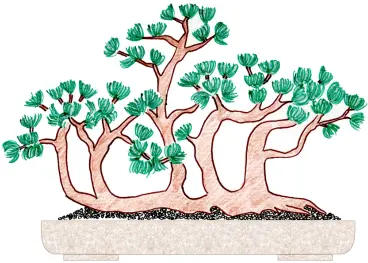
The raft or straight-line bonsai style mimics a tree which is fallen but has some of its roots still attached to the soil. There is also another variation in raft bonsai style that is called as ‘netsunagari‘.
One side of the whole tree lay on the ground with its branches broken.
After some time the branches will have their own set of roots and will start growing vertically.
Eventually, the old root rots and the whole setup looks as if separate trees are growing together.
Double trunk Bonsai style – Sokan

In nature, double trunks are common, however, they aren’t that common in Bonsai. In most cases, both trunks grow from the same root system, but it’s possible for the smaller trunk to grow from the larger trunk above ground.
There is a difference in thickness and length between the two trunks, the thicker and more developed trunk grows nearly upright, while the smaller trunk grows slanted. Combined, both trunks will produce a single canopy or crown of leaves.
Twin trunk Bonsai style – Soju

In bonsai styles, twin-trunks are a popular arrangement. This bonsai style is achieved when a tree grows from the soil with two trunks. The style is called a ‘mother and child‘ when the trunks are separated.
Seeds germinating close to each other may produce twin trunks such as this. Plants naturally graft together as they grow, merging into one plant at the base.
The bonsai twin-trunk tree can be created either by planting two or more trees very close together or by starting with a tree with multiple trunks. In case of multiple trunks, remove the rest of the trunks leaving just 2 trunks. Select the best pair of the trunks.
There are also other multiple trunk styles:
- 3 trunks – Sambon-Yose
- 5 trunks – Gohon-Yose
- 7 trunks – Nanahon-Yose
- 9 trunks – Kyuhon-Yose
- More than 9 trunks – Yose-Ue
Multitrunk aka clump Bonsai style – Kabudachi

The most common way to make clump bonsai style is to tie several young trees together at the base for several years, which will allow them to naturally graft together.
A single root system feeds all trunks, so there is only one tree. Several trunks form one crown of leaves, topped by the thickest and most developed trunk.
In the wild, when many seeds germinate together, they end up merging together to form a single tree.
Do not tie the trunks together tightly, as it might damage the trunks.
Weeping Bonsai style – Shidare-Zukuri
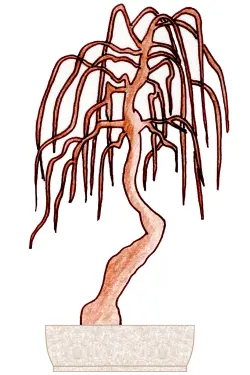
The Weeping Bonsai style is a unique approach to bonsai cultivation. It creates the illusion of a tree that droops or weeps, evoking elegance and tranquility.
This style involves careful pruning and training techniques to shape the branches downward. The chosen tree species, such as willows or junipers, contribute to the desired effect.
In addition to the aesthetic appeal, the Weeping Bonsai style also symbolizes the impermanence and transience of life. It reflects the concept of embracing change and the graceful acceptance of life’s ups and downs. The drooping branches and delicate foliage convey a sense of vulnerability and remind us of the fragile nature of existence.

